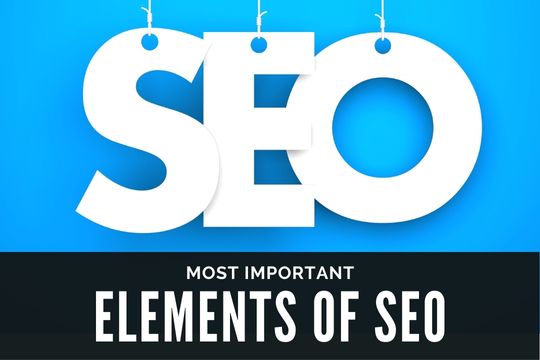
The pandemic made online commerce comparatively easy for all comers for a while. Everyone was buying just about everything online. Then, the pandemic started winding down, and people started going back to shopping in stores. The landscape got very competitive, and websites that didn’t lay a strong SEO foundation started to flounder. Of course, this is nothing new. A look back at our small business challenges in 2021 post show that SEO was a concern even then. If you’re worried that your SEO game isn’t making the grade, keep reading for the seven most important elements of SEO.

Like it or not, mobile searches and visiting websites on mobile devices are now the de facto standard. In 2022, around sixty percent of all internet traffic went through mobile devices. Beyond that, when analyzing websites, Google has adopted a mobile-first strategy. In other words, Google evaluates and ranks your web pages based largely on how well they perform on mobile devices, making it one of the most important elements of SEO.
Or, at the very least, they look for the technical indicators that your site will perform well on mobile devices. Google has a black-box attitude about what its algorithms evaluate, so you can never know. The important part is that your site must look great and behave flawlessly on phone screens of all sizes.
Technical SEO is a vast subject area, but there are some areas that you can focus on to please search engines. Right at the top is something that sounds simple but often is simple: page load speeds. The rule of thumb is that the faster your page loads, the better off you are. The research has shown that the slower your pages load, the more visitors you lose.
Of course, it’s rarely just one thing that slows down your page load speeds. Common culprits include large image files, excessive JavaScript, too many ads, and poor caching. Other things to watch out for are a lack of schema markup, no XML sitemap, lack of header tags, no meta description, and ignoring alt-tags.
Content may come third on this list, but it’s by no means third in importance. Why? Content is the part of SEO you can exert the most control over. First and foremost, you need high-quality content. To translate that, you need content highly relevant to your industry/audience, usefulness, and consistency. Without those three things, your content will fall flat as often as not. Poor quality content will not attract visitors. It will not build trust. It will not help you secure sales.
Unfortunately, SEO does have concerns beyond the quality of the content. For search engines to appropriately categorize and rank your content, its signifiers must pigeonhole it. That means keywords. No, not keyword stuffing. You must pick keywords specific to your business or industry and related topics. With those keywords, Google can direct visitors to your site when appropriate.

Links fall into some kind of weird no man’s land of SEO. They aren’t exactly content. They aren’t precisely technical SEO. They don’t make your site more mobile-friendly. Yet, Google pays a lot of attention to them. You can divide links into three broad categories: internal, inbound, and outbound.
Internal links are the links that cross-connect content on your website. For example, if you sell customer relationship management software and write a blog post about CRM software, you’d drop a link to your software in your blog post.
Inbound links are generally the Holy Grail of linking. Those are links to your pages, blog posts, or products others post on their websites. The higher the profile of those sites, the better it is for you. Google reads that as trustworthy or high authority sites acknowledging your site.
Outbound links are a way of establishing your credibility. When you write about a topic, you want to link to high-profile, high-authority sites. If you quote stats, for example, you want to link those stats to a government site, university site, or business site specializing in data.
In other words, don’t neglect your linking.
User experience is one of those terms with a lot of industry cachet, but it’s also an umbrella term that captures a lot of related issues. In a nutshell, user experience is about making it so that users run into as few hiccups on your site as possible. Some of that boils down to good site design, such as making your navigation simple and intuitive.
Some of it is about ensuring you provide good information, such as essential business information like your address and contact information. Good user experience is also about getting your technical ducks in a row, like improving page load speeds, eliminating dead links, and ensuring your forms work.
Search intent or user intent is pretty self-descriptive. It’s what the person running the search needs or wants from the search. There are several ways to break it down, but you can usually fit searches into three general intent categories: informational, navigational, and purchase.
Understanding what people want from different searches can help you find better keywords to structure your content around. Informational search intent is going to dovetail with blog content or video content. Navigational search intent will match up well with home pages since the person is searching for a particular site destination. Purchase intent will help you align product or service pages with keywords.

Granted, social sharing or social signals are not a factor that Google weighs directly. At least, they give it the same weight as other factors. Yet, there is an almost inevitable knock-on effect to social sharing. The more traction your content gets on social media, the more likely a high authority site will link to it. That, of course, is something that Google does measure.
Plus, even if you don’t get a direct SEO boost, robust social sharing probably will get more people onto your site, which is the end goal of search engine optimization. The takeaway is that you should make it easy for people to share your content on social media.
The elements listed above are among the seven most important elements of SEO. Minimally, they are all essential SEO elements you can’t ignore. Look to your keywords and content if you want a place to start. Those are the easiest to manage yourself. If you don’t feel like you’ve got the chops for the other, more technical element, find a partner specializing in e marketing consulting to help you get your SEO game in order.
Google now judges pages mainly by their phone performance. With around sixty percent of traffic coming from mobiles, a site that loads fast, fits small screens, and functions smoothly stands a much better chance of ranking well and keeping visitors engaged.
Technical SEO covers page speed, schema markup, XML sitemaps, header tags, meta descriptions, alt-tags, and minimizing heavy files or scripts. Fixing these helps search engines crawl faster and gives users quicker, error-free pages.
Focus on creating high-quality, relevant, consistent content, then place carefully chosen keywords that match your industry, audience, and search intent. Avoid keyword stuffing; instead, use specific terms naturally so search engines can categorize and display your pages appropriately.
Internal links connect pages within your site, guiding visitors and spreading authority. Inbound links come from other domains and act as high-value endorsements. Outbound links point to authoritative external sources, supporting your claims and credibility. All three signal usefulness to Google.
Social shares are not a direct Google ranking factor, yet popular posts often attract valuable inbound links and extra traffic. Making content easy to share can indirectly boost authority and visibility, strengthening overall SEO performance.